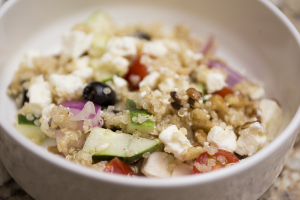Article and audio introduction by Samantha Kennedy, Family and Consumer Sciences
There are always a number of nutritional trends out there, with a new one emerging nearly every day. Some of the more recent trends include the increased consumption of “superfoods” such as acai berries, pomegranate juice, and kale. However, one of the more enduring trends involves what are commonly called “ancient grains.”
What are ancient grains?
There is no formal definition, but the general consensus is that ancient grains are types of whole grains that have remained relatively unchanged over thousands of years. These seeds and cereals contain a lot of healthy nutrients such as fiber, protein, complex carbohydrates, vitamins, and minerals.
Ancient grains, along with other types of whole grains, have been shown to have positive effects on heart health. So it is no surprise to find so many products out there that contain one or more of these grains.

Many of these ancient grains are versatile, adding a complementary flavor or texture to common foods such as porridge, pasta, and pancakes. They can be combined with more traditional grains such as wheat to add a nutritious boost to many foods like cereal or muffins.
While ancient grains are becoming more and more popular, they are often still relegated to specialty stores or the international food sections of mainstream supermarkets. Ancient grains can also be ordered online and shipped directly to the consumer, thereby saving time searching around town.
Types of ancient grains
What are some examples of ancient grains and what are their benefits? Here are just a few.
Amaranth. While not technically a grain at all, amaranth functions much like grains in foods and therefore is included in this group. Like quinoa, it contains all the essential amino acids. It is also high in protein and gluten-free, which is a benefit for those with celiac disease.
Buckwheat. Gluten-free and rich in protein, this ancient grain also contains high levels of the antioxidant rutin, which may help improve circulation and prevent LDL (“bad”) cholesterol from blocking blood vessels. It is very culinarily versatile, and is used to make Japanese soba noodles and pancakes.
Bulgur. This grain hails from the Middle East and the Mediterranean. It has more fiber than quinoa, buckwheat, millet, and corn. It cooks easily in hot water and its mild flavor makes it perfect for those who are just getting used to eating and cooking with whole grains.
Farro. This is a type of wheat that was commonly used in ancient Italy. Many believe it makes the best pasta. It is very high in fiber and contains more antioxidants than many other grains. Be sure to buy whole farro and not pearled farro to ensure the product is whole grain.
Millet. I used to give this as a treat to my pet parakeets when I was kid. But it is not just for the birds! Millet is naturally rich in protein and antioxidants and is helpful in controlling blood sugar and cholesterol. Used in a lot of different dishes, it is most commonly found in flatbreads and desserts. It can also be ground into flour or prepared as polenta in place of cornmeal.
Quinoa. This is one whose popularity has exploded in the last few years. Pronounced “keen-wah,” this grain provides a delicious chewy texture to soups and salads. It is unique among plant foods because it contains all of the essential amino acids – those building blocks of proteins that we do not make ourselves and must obtain through our diet.
Sorghum. This ancient grain is rich in antioxidants and is also gluten-free. It can be eaten like popcorn, cooked into porridge, or even brewed into beer. It is also a great addition to soups, stews, and salads.
Ancient grains are versatile, nutritious, and delicious. They can add extra protein, fiber, and antioxidants to nearly any type of dish and provide a flavorful chewy texture beyond traditional grains. For more information on how to add these grains to a healthy diet, please call Samantha Kennedy, Family and Consumer Sciences agent, at (850) 926-3931.
Related articles
The whole grain goodness of modern and ancient grains (Harvard Health Blog)
What are ‘Ancient Grains’? (Iowa State University Extension)
Start Your Day with Whole Grains (UF/IFAS Extension – Living Well in the Panhandle)
Extension classes are open to everyone regardless of race, creed, color, religion, age, disability, sex, sexual orientation, marital status, national origin, political opinions or affiliations.
 0
0
